بِسۡمِ اللهِ الرَّحۡمٰنِ الرَّحِيۡمِ
Introduction
The precision of prayer timings holds paramount importance as they dictate the legitimacy of our prayers (salawat) and the validity of our fasts, particularly during Ramadan. It is imperative to ascertain the commencement of a specific prayer time before engaging in prayer rituals.
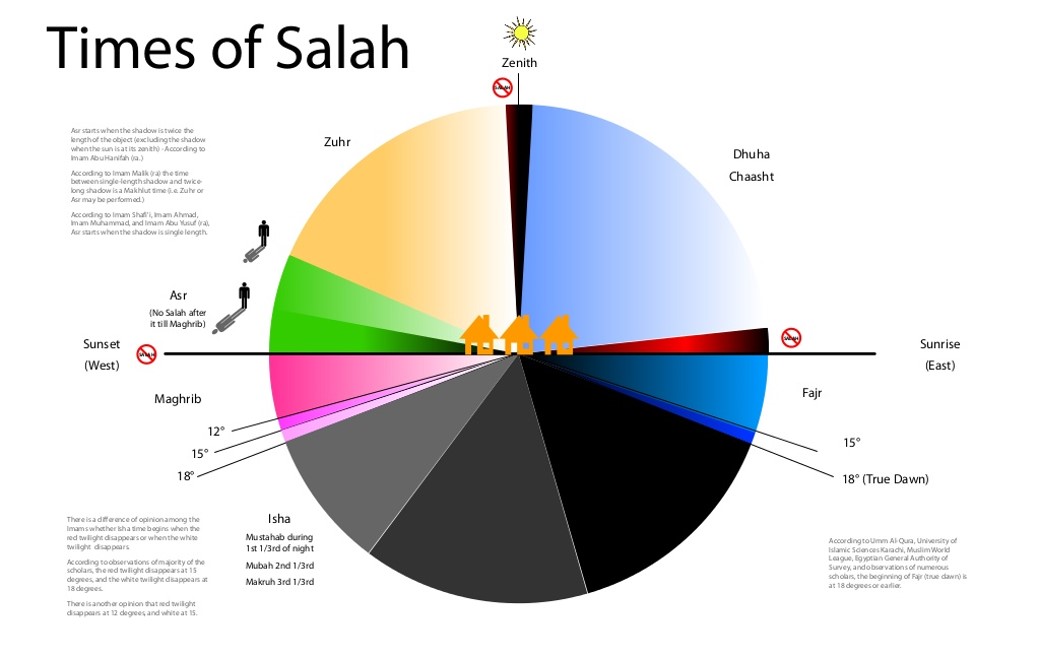
In my residing area of Kirklees, encompassing over 50 Islamic institutions within a 5-mile radius, one would anticipate a uniformity in prayer timetables, given the consistent sunrise, solar midday, and sunset occurrences throughout the year across the three towns constituting Kirklees. However, the proliferation of divergent timetables is a notable anomaly within the region, hinting at a potential fragmentation within the Muslim community. Addressing this fragmentation and fostering unity within the community serves as the primary motivation behind this discourse.
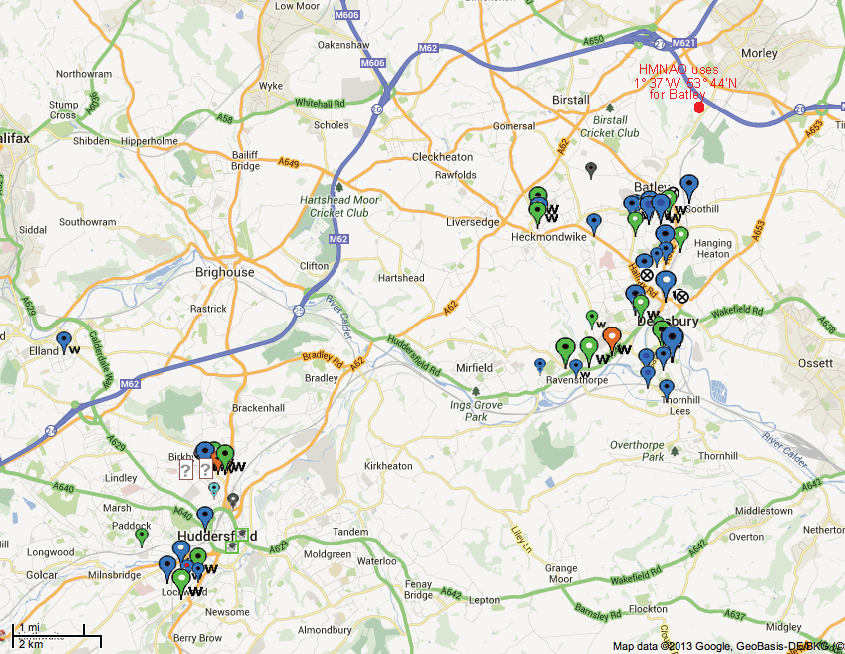
Despite the availability of a singular source of raw data primarily from the HMNAO, leading to near-identical datasets, the divergence in prayer timetables persists. This discrepancy is exacerbated by the visual nature of Islamic prayer timings, which are subject to atmospheric conditions, thus necessitating caution to prevent inadvertent prayers during forbidden times or the inadvertent nullification of Ramadan fasts.
Determining the Start Time of Fajr Prayer in the United Kingdom During Summer
Geographical considerations, especially in the UK, pose unique challenges, notably in determining Fajr and Isha timings. Persistent twilight periods during summer months present a particular challenge, as the sun's depression below the horizon does not reach the required 18° angle, as shown in the fig. below, leading to extended twilight durations. Various methodologies have been proposed to address this issue, including Aqrabul-Ayyam, Nisf-ul-Layl, Aqrabul-Bilad, and Wahid Sub' al-Layl, each with distinct implications for prayer and fasting times, particularly during Ramadan.
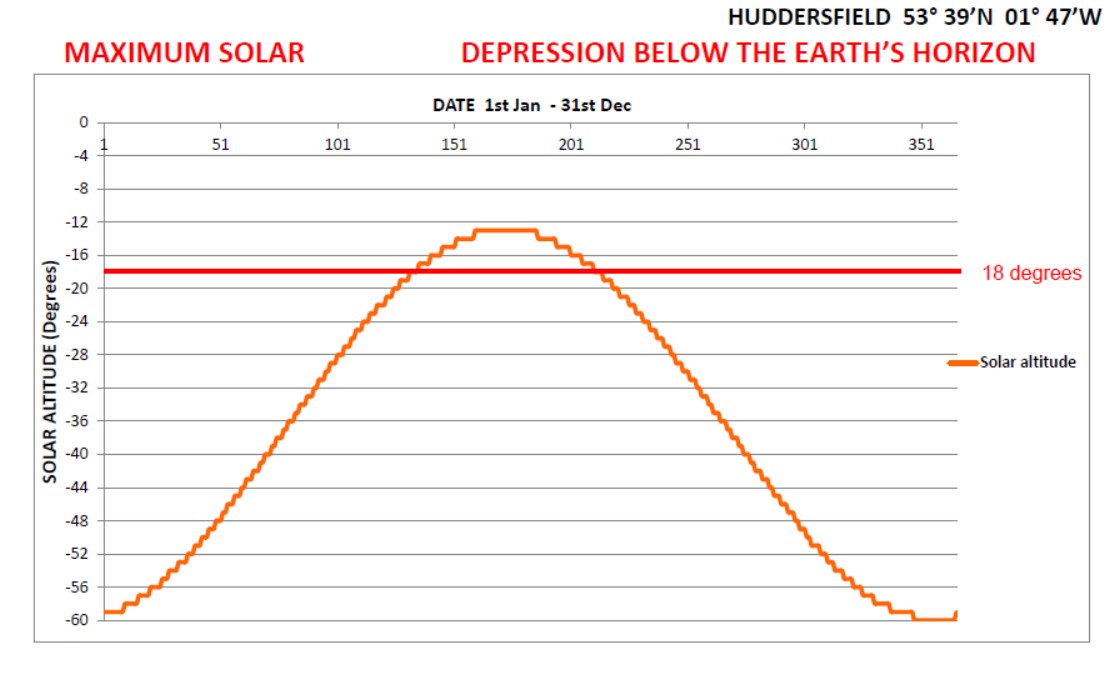
The overwhelming majority opinion of Islamic scholars throughout history has been the 18° solar depression marking the onset of Fajr underscores the significance of adhering to established principles. However, divergent viewpoints exist, with some advocating for alternative criteria. This discrepancy extends to the determination of Isha timings and raises fundamental questions regarding the universality of the 18° criterion.
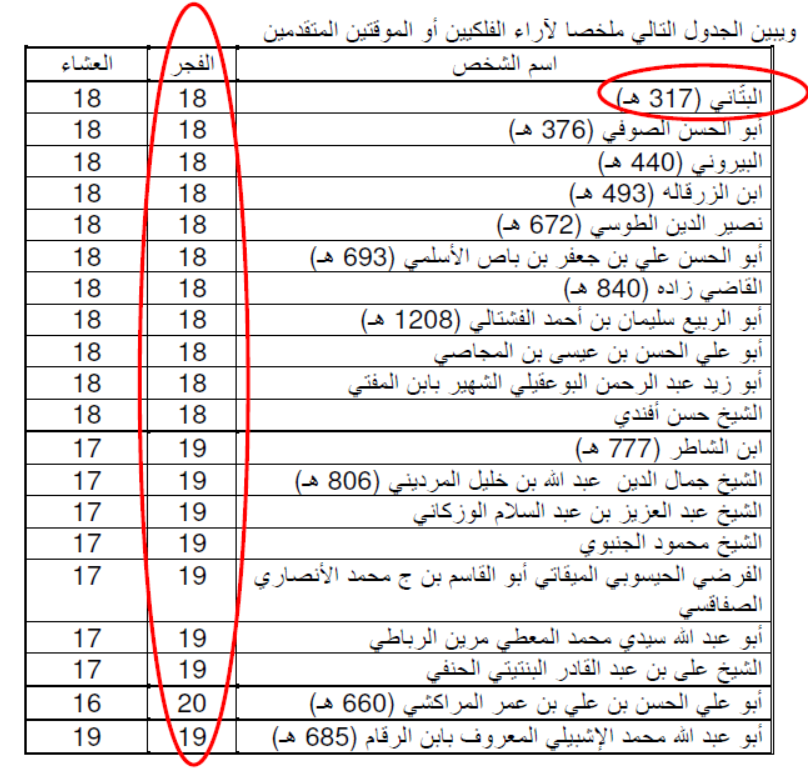
In meetings of UK scholars in 1983 in Bradford and of international scholars in 1984 in London it was agreed to follow the 18° solar depression criteria for start of Fajr times, as shown below.
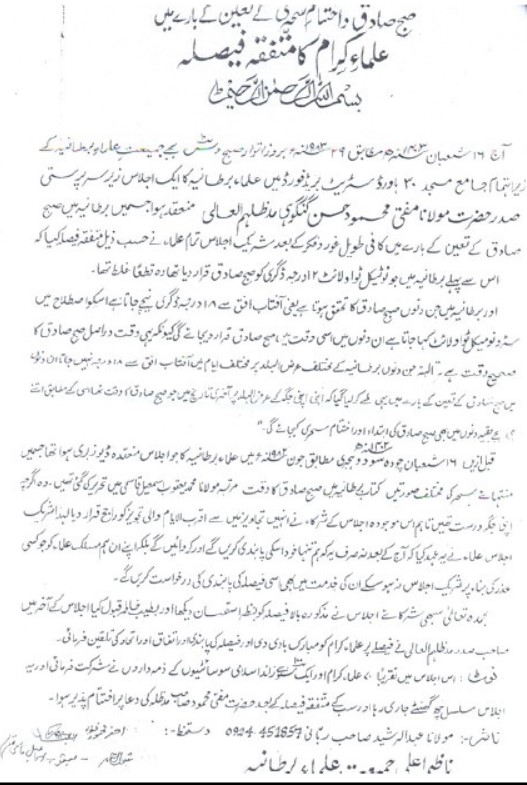
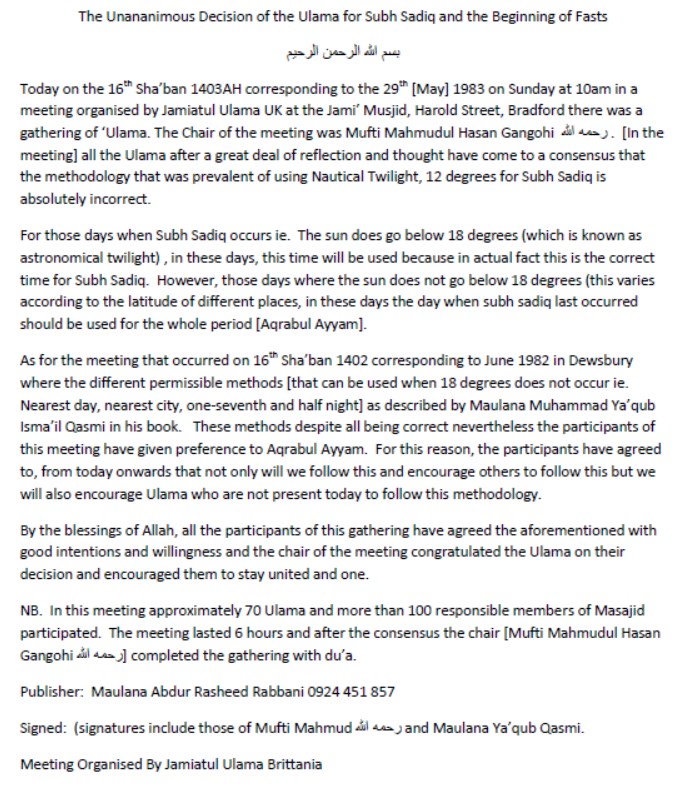

Practical considerations, such as adjustments to raw data and the implementation of precautionary measures, further complicate the construction of prayer timetables. The inclusion of a margin of error becomes crucial, especially during persistent twilight periods, to ensure the integrity of prayer timings and the preservation of fasting rituals.
The graphs below show the duration of fast when Ramadan occurs during the persistent twilight period in the Summer months. The application of the methodologies of aqrabul-ayyam and nisf-ul-layl result in the duration matching the daylight hours through the year whereas the methodologies of aqrabul-bild and sub' al-layl result in sudden changes in the duration of the fast from one day to the next which is totally illogical.
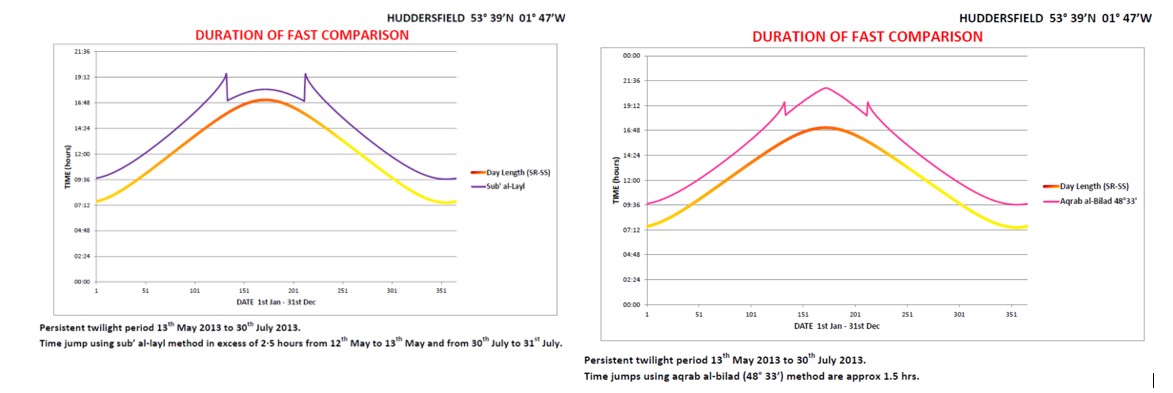
In conclusion, while efforts have been made to standardize prayer timetables and reconcile differing methodologies, challenges persist. It is imperative to remain cognizant of the limitations inherent in determining prayer timings, particularly in regions with unique geographical characteristics. Moreover, fostering unity within the Muslim community requires a collective willingness to prioritize cooperation over individual interests, ultimately serving the greater good of the community as a whole.
Determining the Timing of Isha Prayer in the United Kingdom During Summer
The determination of the timing for the Isha prayer in the United Kingdom (UK) during the summer months is a matter of interpretation and application of Islamic legal principles. According to the teachings of Imam Abu Hanifa (![]() ), the onset of Isha prayer occurs when there is no residual light left in the sky, signifying the disappearance of "shafaq abyad" (whitening twilight) which coincides with 18° solar depression. However, the prominent students of Imam Abu Hanifa (
), the onset of Isha prayer occurs when there is no residual light left in the sky, signifying the disappearance of "shafaq abyad" (whitening twilight) which coincides with 18° solar depression. However, the prominent students of Imam Abu Hanifa (![]() ), namely Imam Muhammad (
), namely Imam Muhammad (![]() ) and Imam Abu Yusuf (
) and Imam Abu Yusuf (![]() ), hold that the commencement of Isha prayer is marked by the disappearance of the sun's red glow, known as "shafaq ahmar" (red twilight), which coincides with 15° solar depression
), hold that the commencement of Isha prayer is marked by the disappearance of the sun's red glow, known as "shafaq ahmar" (red twilight), which coincides with 15° solar depression
The disappearance of "shafaq abyad" corresponds to the conclusion of astronomical twilight, while the disappearance of "shafaq ahmar" aligns with the conclusion of nautical twilight, which occurs at 15° below the horizon. The Hanafi school of thought adheres to Imam Abu Hanifa's (![]() ) stance on this matter. Consequently, many scholars in the UK advocate for the permissibility of using the 15° criterion for determining the timing of Isha prayer. Additionally, the Wifaq-ul Ulema has endorsed a method that limits the Isha prayer time to 65 minutes after astronomical sunset on the longest day of the year.
) stance on this matter. Consequently, many scholars in the UK advocate for the permissibility of using the 15° criterion for determining the timing of Isha prayer. Additionally, the Wifaq-ul Ulema has endorsed a method that limits the Isha prayer time to 65 minutes after astronomical sunset on the longest day of the year.
Various methodologies have been proposed to address the challenges associated with determining the timing of Isha prayer during the summer months. These methodologies often involve combining the 18° or 15° criterion with the "sub' al-layl" method, which calculates the start of the night based on the duration between sunset and sunrise. The selection of an appropriate methodology relies on practical considerations and empirical analysis of prayer times.
An analysis of generated timetables reveals that the interval between Maghrib (sunset) and Isha prayer varies depending on the methodology employed. Utilizing either the 15° or 18° criterion combined with the "sub' al-layl" method yields intervals ranging from 54 minutes to 1 hour and 46 minutes. However, the timing of Isha prayer remains consistent when using a fixed upper time limit or the interval between astronomical sunset and Isha prayer.
Consistency in applying legal theory is emphasized, particularly concerning the choice between different rulings issued by Islamic authorities. It is essential to adhere to the rulings of a specific authority for both Fajr (dawn) and Isha prayer times. Additionally, the importance of Fajr start times, which coincide with the end of suḥūr (pre-dawn meal) during Ramadan, is underscored.
The significance of revising prayer timetables based on accurate methodologies is acknowledged, despite potential resistance from local communities. Scholars urge a proactive approach to address discrepancies and ensure adherence to Islamic principles. The article concludes by providing a timetable for Huddersfield, developed using the 18° solar depression criterion for Fajr times, and the concept of aqrabul-ayyam for subh sadiq during the persistent twilight period in the Summer months and the 15° solar depression criterion combined with the "sub' al-layl" method for Isha times. Scholars are invited to review and validate the timetable, fostering dialogue and refinement in the process of determining prayer times.

The whole year prayer timetable for Huddersfield is attached below.
A. Hussain
| Attachment | Size |
|---|---|
| Hiddersfield Salaah Times 2022 FIW.pdf | 39.17 KB |
| Attachment | Size |
|---|---|
| Hiddersfield Salaah Times 2023 FIW.pdf | 39 KB |
| Attachment | Size |
|---|---|
| Huddersfield_Salaah_Times_2024 update.pdf | 43.17 KB |
| Attachment | Size |
|---|---|
| Huddersfield_Salaah_Times_2025 update.pdf | 43.06 KB |
